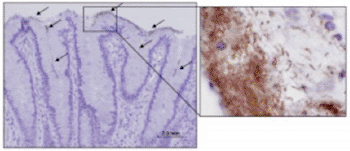Novel Pig Model Closely Mimics Human Helicobacter pylori Infection
By LabMedica International staff writers
Posted on 08 Oct 2013
Researchers have developed a novel pig model of Helicobacter pylori infection that closely mimics human gastric pathology and presents an avenue for studying human effector and regulatory responses toward H. pylori.Posted on 08 Oct 2013
H. pylori are helix-shaped, Gram-negative bacteria, about three micrometers long with a diameter of about 0.5 micrometers. They are microaerophilic, requiring oxygen but at a lower concentration than is found in the atmosphere. H. pylori contain a hydrogenase, which can be used to obtain energy by oxidizing molecular hydrogen produced by intestinal bacteria. While more than 50% of the world's population harbor H. pylori in their upper gastrointestinal tract, over 80% of people infected with H. pylori show no symptoms. Acute infection may appear as an acute gastritis with abdominal pain or nausea. Where this develops into chronic gastritis, the symptoms, if present, are often those of non-ulcer dyspepsia: stomach pains, nausea, bloating, belching, and sometimes vomiting or black stool. Individuals infected with H. pylori have a 10% to 20% lifetime risk of developing peptic ulcers and a 1% to 2% risk of acquiring stomach cancer.

Image: Similar anatomical properties between the stomach of humans and pigs may facilitate study of H. pylori-associated disease. Virginia Tech researchers have demonstrated that H. pylori (arrow) is found in the inner lining of the stomach and near aggregates of immune cells. The picture insert shows the typically spindle-shaped H. pylori magnified 1,000 times (Photo courtesy of Virginia Tech).
Small animals such as mice and gerbils have been used as models for H. pylori infection. However, the immune response generated by these animals was found to differ significantly from that of humans. In a paper published in the October 2013 issue of the journal Infection and Immunity investigators at Virginia Tech (Blacksburg, VA, USA) described a novel pig model for studying H. pylori infection.
Similar to the situation in humans, when pigs were infected with H. pylori, the animals generated an increase in pro-inflammatory CD4+ T helper cells, followed by an increase in CD8+ cytotoxic T cells. Marked rises were found in the levels of mRNA needed by peripheral blood mononuclear cells (PBMCs) for the production of inflammatory proteins such as gamma interferon, perforin, and granzyme.
“Pigs have greater anatomic, physiologic, and immunologic similarities to humans than mice, the main animal model used in biomedical research,” said senior author Dr. Raquel Hontecillas, assistant professor of immunology at Virginia Tech. “The results from our new pig model closely mimic what has been reported in clinical settings, which will allow us to comprehensively and systematically investigate human immune responses to H. pylori.”
Related Links:
Virginia Tech














